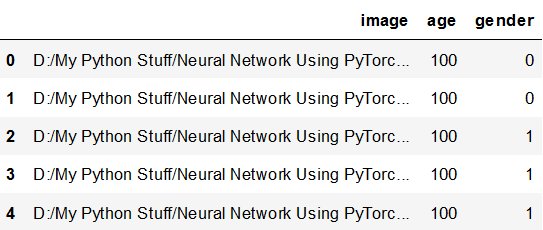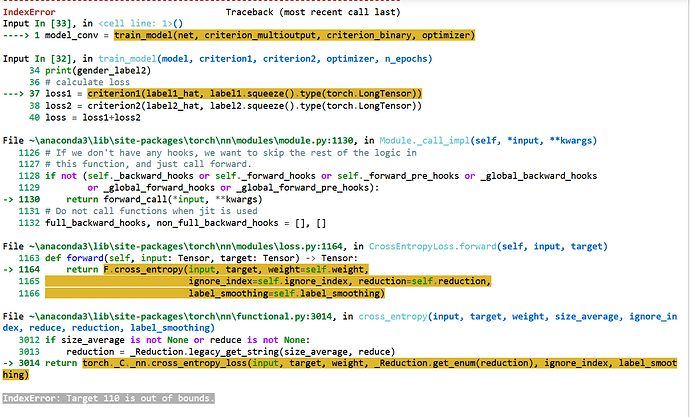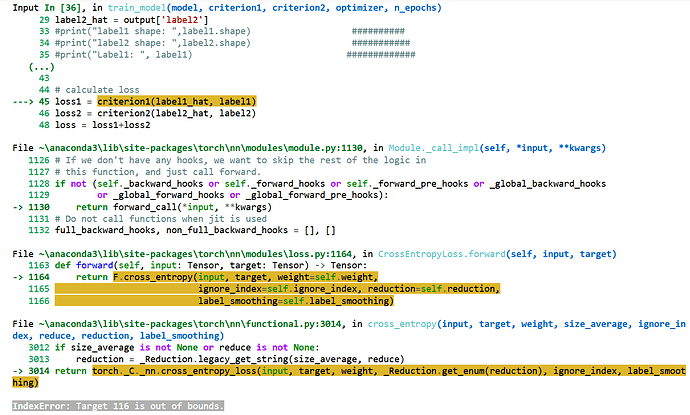After epoch 1 it is throwing this error. Batch_size is 50.
Epoch 1, Batch 1 loss: 5.308178
‘’’
Building Model
import torch.nn as nn
import torch.nn.functional as F
class Net(nn.Module):
def init(self):
super(Net, self).init()
self.conv1 = nn.Conv2d(in_channels = 1, out_channels = 32, kernel_size = 3, padding=1, stride=1)
self.relu = nn.ReLU()
self.maxpool = nn.MaxPool2d(kernel_size = 2)
self.conv2 = nn.Conv2d(in_channels = 32, out_channels = 64, kernel_size = 3, padding=1, stride=1)
self.conv3 = nn.Conv2d(in_channels = 64, out_channels = 128, kernel_size = 3, padding=1, stride=1)
self.conv4 = nn.Conv2d(in_channels = 128, out_channels = 256, kernel_size = 3, padding=1, stride=1)
#nn.Flatten()
self.fc1 = nn.Linear(in_features = 16384, out_features = 8192)
self.fc2 = nn.Linear(in_features = 8192, out_features = 256)
self.linear1 = nn.Linear(in_features = 256, out_features = 100) # For age class output
self.linear2 = nn.Linear(in_features = 256, out_features = 2) # For gender class output
def forward(self, x):
out = self.conv1(x)
out = self.relu(out)
out = self.maxpool(out)
out = self.conv2(out)
out = self.relu(out)
out = self.maxpool(out)
out = self.conv3(out)
out = self.relu(out)
out = self.maxpool(out)
out = self.conv4(out)
out = self.relu(out)
out = self.maxpool(out)
out = out.view(x.size(0),-1)
out = F.sigmoid(self.fc1(out))
out = F.sigmoid(self.fc2(out))
label1 = torch.sigmoid(self.linear1(out)) # Age output
label2 = torch.sigmoid(self.linear2(out)) # Gender output
return {'label1': label1, 'label2': label2}
‘’’
‘’’
import torch.optim as optim
For multilabel output:Age
criterion_multioutput = nn.CrossEntropyLoss()
For binary output:Gender
criterion_binary = nn.CrossEntropyLoss()
optimizer = optim.SGD(net.parameters(), lr=0.001)
‘’’
‘’’
def train_model(model, criterion1, criterion2, optimizer, n_epochs=25):
“”“returns trained model”“”
# initialize tracker for minimum validation loss
valid_loss_min = np.Inf
for epoch in range(1, n_epochs):
train_loss = 0.0
valid_loss = 0.0
# train the model #
model.train()
for batch_idx, sample_batched in enumerate(train_dataloader):
image, label1, label2 = sample_batched
# importing data and moving to CPU
image, label1, label2 = sample_batched[X_train].to(device),\
sample_batched[y_age_train].to(device),\
sample_batched[y_gender_train].to(device)
print(type(sample_batched))
# zero the parameter gradients
optimizer.zero_grad()
output = model(image.float())
output = model(image.float())
print(output)
label1_hat = output['label1']
label2_hat = output['label2']
#label3_hat=output['label3']
# calculate loss
print(label1.shape)
loss1 = criterion1(label1_hat, label1.squeeze().type(torch.LongTensor))
loss2 = criterion2(label2_hat, label2.squeeze().type(torch.LongTensor))
#loss3=criterion1(label3_hat, label3.squeeze().type(torch.LongTensor))
loss = loss1+loss2
# back prop
loss.backward()
# grad
optimizer.step()
train_loss = train_loss + ((1 / (batch_idx + 1)) * (loss.data - train_loss))
if batch_idx % 50 == 0:
print('Epoch %d, Batch %d loss: %.6f' %
(epoch, batch_idx + 1, train_loss))
# validate the model #
model.eval()
for batch_idx, sample_batched in enumerate(test_dataloader):
image, label1, label2 = sample_batched
image, label1, label2 = sample_batched[X_test].to(device),\
sample_batched[y_age_test].to(device),\
sample_batched[y_gender_test].to(device),\
#sample_batched[‘label_race’].to(device)
print(type(image))
output = model(image.float())
output = model(image.float())
label1_hat = output['label1']
label2_hat = output['label2']
#label3_hat=output['label3']
# calculate loss
loss1=criterion1(label1_hat, label1.squeeze().type(torch.LongTensor))
loss2=criterion2(label2_hat, label2.squeeze().type(torch.LongTensor))
#loss3=criterion1(label3_hat, label3.squeeze().type(torch.LongTensor))
loss = loss1+loss2
valid_loss = valid_loss + ((1 / (batch_idx + 1)) * (loss.data - valid_loss))
# print training/validation statistics
print('Epoch: {} \tTraining Loss: {:.6f} \tValidation Loss: {:.6f}'.format(
epoch, train_loss, valid_loss))
## TODO: save the model if validation loss has decreased
if valid_loss < valid_loss_min:
torch.save(model, 'model.pt')
print('Validation loss decreased ({:.6f} --> {:.6f}). Saving model ...'.format(
valid_loss_min,
valid_loss))
valid_loss_min = valid_loss
# return trained model
return model
‘’’
‘’’
model_conv = train_model(net, criterion_multioutput, criterion_binary, optimizer)
‘’’
IndexError Traceback (most recent call last)
Input In [56], in <cell line: 1>()
----> 1 model_conv = train_model(net, criterion_multioutput, criterion_binary, optimizer)
Input In [55], in train_model(model, criterion1, criterion2, optimizer, n_epochs)
29 #label3_hat=output[‘label3’]
30 # calculate loss
31 print(label1.shape)
—> 32 loss1 = criterion1(label1_hat, label1.squeeze().type(torch.LongTensor))
33 loss2 = criterion2(label2_hat, label2.squeeze().type(torch.LongTensor))
34 #loss3=criterion1(label3_hat, label3.squeeze().type(torch.LongTensor))
File ~\anaconda3\lib\site-packages\torch\nn\modules\module.py:1130, in Module._call_impl(self, *input, **kwargs)
1126 # If we don’t have any hooks, we want to skip the rest of the logic in
1127 # this function, and just call forward.
1128 if not (self._backward_hooks or self._forward_hooks or self._forward_pre_hooks or _global_backward_hooks
1129 or _global_forward_hooks or _global_forward_pre_hooks):
→ 1130 return forward_call(*input, **kwargs)
1131 # Do not call functions when jit is used
1132 full_backward_hooks, non_full_backward_hooks = [], []
File ~\anaconda3\lib\site-packages\torch\nn\modules\loss.py:1164, in CrossEntropyLoss.forward(self, input, target)
1163 def forward(self, input: Tensor, target: Tensor) → Tensor:
→ 1164 return F.cross_entropy(input, target, weight=self.weight,
1165 ignore_index=self.ignore_index, reduction=self.reduction,
1166 label_smoothing=self.label_smoothing)
File ~\anaconda3\lib\site-packages\torch\nn\functional.py:3014, in cross_entropy(input, target, weight, size_average, ignore_index, reduce, reduction, label_smoothing)
3012 if size_average is not None or reduce is not None:
3013 reduction = _Reduction.legacy_get_string(size_average, reduce)
→ 3014 return torch._C._nn.cross_entropy_loss(input, target, weight, _Reduction.get_enum(reduction), ignore_index, label_smoothing)
IndexError: Target 103 is out of bounds.
I tried to solve this error but it could not. Thank you in advance.


